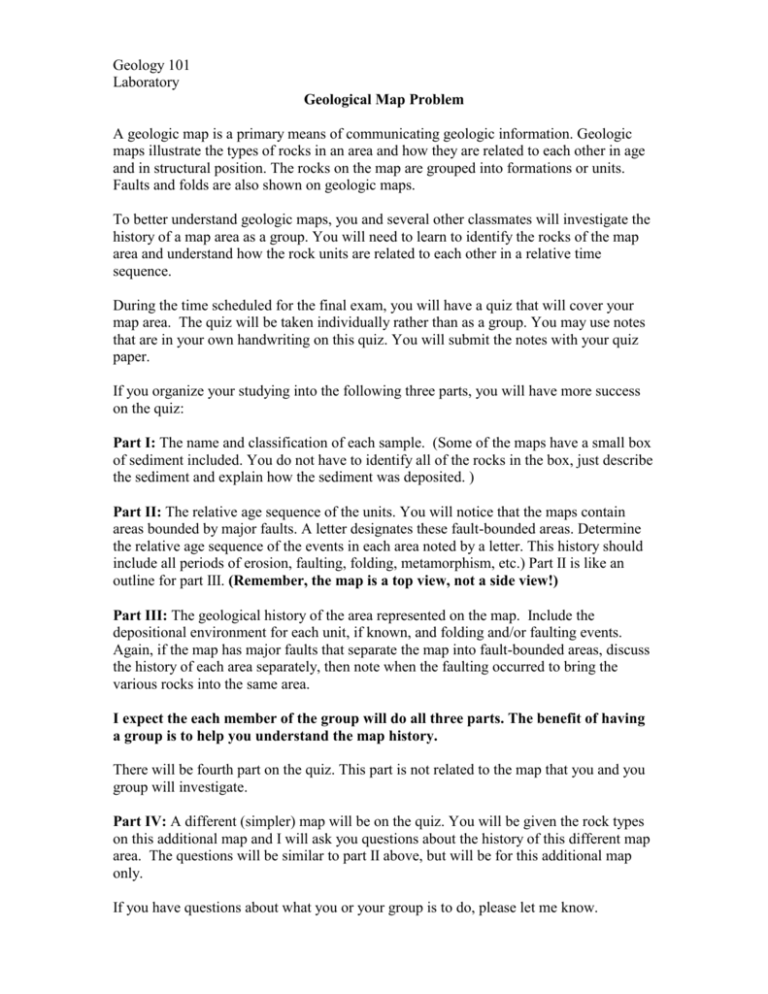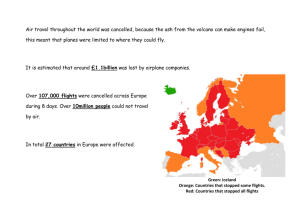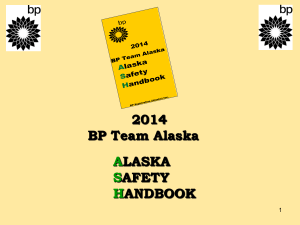Geology 101 - Cloudfront.net
advertisement

Geology 101 Laboratory Geological Map Problem A geologic map is a primary means of communicating geologic information. Geologic maps illustrate the types of rocks in an area and how they are related to each other in age and in structural position. The rocks on the map are grouped into formations or units. Faults and folds are also shown on geologic maps. To better understand geologic maps, you and several other classmates will investigate the history of a map area as a group. You will need to learn to identify the rocks of the map area and understand how the rock units are related to each other in a relative time sequence. During the time scheduled for the final exam, you will have a quiz that will cover your map area. The quiz will be taken individually rather than as a group. You may use notes that are in your own handwriting on this quiz. You will submit the notes with your quiz paper. If you organize your studying into the following three parts, you will have more success on the quiz: Part I: The name and classification of each sample. (Some of the maps have a small box of sediment included. You do not have to identify all of the rocks in the box, just describe the sediment and explain how the sediment was deposited. ) Part II: The relative age sequence of the units. You will notice that the maps contain areas bounded by major faults. A letter designates these fault-bounded areas. Determine the relative age sequence of the events in each area noted by a letter. This history should include all periods of erosion, faulting, folding, metamorphism, etc.) Part II is like an outline for part III. (Remember, the map is a top view, not a side view!) Part III: The geological history of the area represented on the map. Include the depositional environment for each unit, if known, and folding and/or faulting events. Again, if the map has major faults that separate the map into fault-bounded areas, discuss the history of each area separately, then note when the faulting occurred to bring the various rocks into the same area. I expect the each member of the group will do all three parts. The benefit of having a group is to help you understand the map history. There will be fourth part on the quiz. This part is not related to the map that you and you group will investigate. Part IV: A different (simpler) map will be on the quiz. You will be given the rock types on this additional map and I will ask you questions about the history of this different map area. The questions will be similar to part II above, but will be for this additional map only. If you have questions about what you or your group is to do, please let me know. Geology 101 Geological Map 1 9 7 12 2 6 5 8 11 7 4 N 10 3 9 6 5 12 8 4 7 3 6 5 4 3 2 Area A 40 1 17 15 Area B 15 18 14 15 14 16 13 14 15 16 19 Additional Data: Rock type Age Rock type Age 9 Cretaceous 15 1.7 billion years old 10 Oligocene 16 1.7 billion years old 11 Pliocene 17 Triassic 13 600 million years old 18 800 million years old The contacts between rock types 5 and 6 and 6 and 7 show slight metamorphism. Faults with “barbs” are thrust faults. The barb points to the upper plate. See your text for further explanation. Geology 101 Geological Map 2 6 Area B 1 Area A 4 17 N 2 3 16 4 15 5 14 13 6 30 7 8 8 18 15 7 14 6 13 5 9 10 11 Area C 12 Additional data: Rock type 2 3 4 5 Age 1.7 billion 1.7 billion 800 million Pennsylvanian Rock type 8 10 12 13 17 Age Triassic Pliocene Mississippian Devonian Permian Geology 101 Geological Map 3 12 18 30 8 8 18 9 12 11 8 river 12 10 10 13 11 Area D 6 15 5 Area B Area A Area D 7 Area C 10 12 N 14 15 11 2 5 13 45 5 4 16 12 3 2 1 20 2 17 13 Additional Data: Rock Age type 1 Pennsylvanian 2 4000 years 5 Cambrian 7 Devonian 8 Precambrian The river is in the bottom of a canyon. Rock type Age 10 13 14 15 17 Oligocene Miocene Triassic Triassic Cretaceous Geology 101 Geological Map 4 2 Area C 1 4 3 8 5 Area A 8 9 6 Lake 1 10 7 1 11 1 12 12 13 14 15 13 30 16 14 N 15 40 Area B 16 17 17 Additional data: Rock type Age 1 ages vary within period of 2000-5000 years age 2 1.4 billion 3 1.4 billion 5 2800 years 6 4000 years 7 4200 years Rock type 9 11 12 13 17 Age 800 million 800 million 1.7 billion Pennsylvanian Cretaceous Geology 101 Geological Map 5 15 ocean 18 Fault X Area B Fault Z 13 16 13 7 6 14 14 5 14 5 14 8 17 30 6 4 9 3 20 2 10 Area C 10 1 11 Area A 2 3 12 4 5 6 6 6 5 30 7 Additional Data: Rock type Age Rock type Age Rock type Age 1 600 million 8 Paleocene 14 400 million 4 Pennsylvanian 11 Jurassic 16 Oligocene 7 Triassic 12 Jurassic Faults with “barbs “ are thrust faults. The barb points to the upper plate of the thrust fault. See your text for a further description. Geology 101 Geological Map 6 Dinwoody and Park City Fms. Area A 3 2 2 1 3 4 5 6 4 1 60 13 40 14 13 7 13 17 13 14 13 Area B 10 15 12 N 14 11 10 13 14 9 8 30 16 30 Additional Data: Rock types Age Rock types Age 1 Precambrian 15 200 million 5 Cambrian 16 Eocene 6 Pennsylvanian 17 Quaternary 11 Cretaceous The contacts between rock types 8 and 9 and 9 and 10 show slight thermal metamorphism. Faults with the “barbs” are thrust faults. The barb points to the upper plate. See your text for a further description. Geology 101 Geological Map 7 10 11 Fault B 10 2 10 10 3 Fault A 9 9 9 4 9 8 8 7 4 4 5 4 4 3 5 6 5 N 2 4 1 20 Additional Data: Rock type 1 3 4 5 6 9 10 Age Miocene Eocene Devonian Permian Jurassic 1.2 billion 1.2 billion 4 Sediment Sample locations for Map 7 At the locations shown by letters below, sediment samples were taken by drilling into the ground. The data for these drill cores are on two separate sheets. H 11 J rivers F G I E 7 D C B A Sediment Samples for Map 7 (dates before present in parentheses) B A Lahar (2400) Andesitic ash (1100) Andesitic ash (6000) Andesitic ash (2400) Fine dacitic ash (4000) Andesitic ash (6000) Andesitic ash (6600) Coarse andesitic ash (6600) Lahar (8400) Pyroclastic flow (8400) Fine dacitic ash (10300) C D Lahar (100) Pyroclastic flow (1100) Coarse andesitic ash (2400) Coarse andesitic ash (2400) Lahar (4000) Dacitic ash (4000) Andesitic ash (6600) Fine andesitic ash (8400) Lahar (6600) Lahar (10300) F G E Andesitic ash (2400) Coarse andesitic ash (2400) Pyroclastic flow (4000) Dacitic ash (4000) Andesitic ash (6600) Andesitic ash (8400) Pyroclastic flow (6600) Pyroclastic flow (10300) Dacitic ash (10300) Coarse dacitic ash (12500) H G Andesitic ash (1100 Andesitic ash ( 1100) Lahar (2400) Lahar (2400) Dacitic ash (4000) Dacitic ash (4000) Pyroclastic flow (6600) Andesitic ash (6600) Lahar (8400) Dacitic ash (10300) Lahar (8400) Dacitic ash (10300) Coarse dacitic ash (12500) Coarse dacitic ash (12500) I Andesitic ash (100) Andesitic ash (1100) J Andesitic ash (100) Andesitic ash (1100) Dacitic ash (4000) Andesitic ash (2400) Dacitic ash (4000) Coarse andesitic ash (6600) Andesitic ash (6600) Andesitic ash (8400) Dacitic ash (10300) Coarse andesitic ash (8400) Dacitic ash (10300) Dacitic ash (12500) Dacitic ash (12500)








